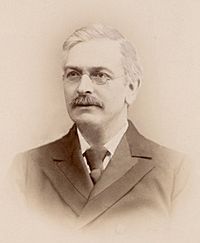Horace Tabberer Brown facts for kids
Quick facts for kids
Horace Brown
|
|
|---|---|
 |
|
| Born |
Horace Tabberer
20 July 1848 Burton, Staffordshire, England
|
| Died | 6 February 1925 (aged 76) Kensington, London
|
| Nationality | British |
| Occupation | Chemist |
| Relatives | Adrian John Brown (half brother) |
Horace Tabberer Brown (born Tabberer; 20 July 1848 – 6 February 1925) was a brilliant British chemist. He made many important discoveries, especially in the world of brewing and plants. He was also a Fellow of the Royal Society, a group of top scientists.
Contents
Early Life and Education
Horace Brown was born in Burton upon Trent, England, on July 20, 1848. His father passed away before he was born. When Horace was about one year old, his mother married Edwin Brown. Edwin was a banker and loved nature. This helped spark Horace's interest in science when he was around 12 years old.
Horace went to school at Burton and Atherstone Grammar Schools. Later, he studied science at the important Royal College of Chemistry.
A Career in Science and Brewing
In 1866, Horace Brown started working at the Worthington Brewery. His main goal was to use science to solve real problems in brewing. He wanted to understand how beer was made at a very basic level.
Key Discoveries in Brewing
Horace Brown studied many different parts of brewing. He looked into:
- How barley seeds start to grow (this is called germination).
- The tiny living things (like bacteria) that affect beer.
- What makes up the water used for brewing.
- How oxygen and fermentation (the process that turns sugar into alcohol) work.
- Why beer sometimes gets cloudy (this is called haze formation).
- The ingredients in wort, which is the liquid before it becomes beer.
- How to test and analyze beer.
He was a true polymath, meaning he was an expert in many different subjects. His work helped improve almost every part of brewing science for over 50 years.
Beyond Brewing: Water and Plants
Horace Brown's early work also included looking at how to treat sewage (wastewater). He also studied the water in Burton upon Trent. This led him to learn about geology, which is the study of Earth's rocks and soil. He even wrote a paper about the rocks in the Leicestershire Coalfield.
In 1889, he became a Fellow of the Royal Society. From 1890 onwards, he began to study how plants take in Carbon dioxide. He also helped start the Guinness Research Laboratory in Dublin in 1901.
Horace Brown passed away in Kensington, London, on February 6, 1925.
Awards and Recognition
Horace Brown received many important awards for his scientific work:
- 1894: The Longstaff Medal from the Chemical Society.
- 1903: A Royal Medal from the Royal Society.
- 1920: The Copley Medal, which is one of the highest awards given by the Royal Society.
The Horace Brown Medal
Today, the Institute of Brewing and Distilling gives out the Horace Brown Medal. This award is given to important scientists every three years. The person who wins the medal is also invited to give a special talk called the Horace Brown Medal lecture.
Some of the winners include:
- Henry Edward Armstrong (the very first winner in 1926)
- Ernest Stanley Salmon (1955)
- John Simpson Ford
- D E Briggs (1999)
- Lionel D Maule (2005)
- Graham Stewart (2008)
- Tim Dolan (2011)
- Charlie Bamforth (2018)

